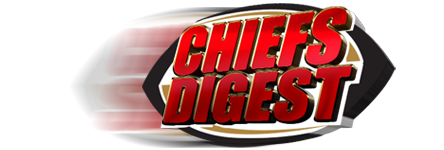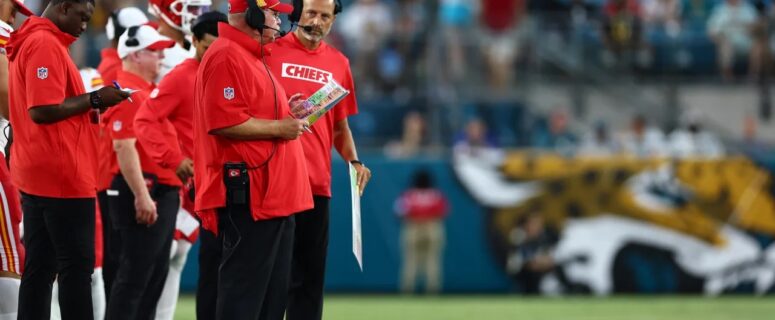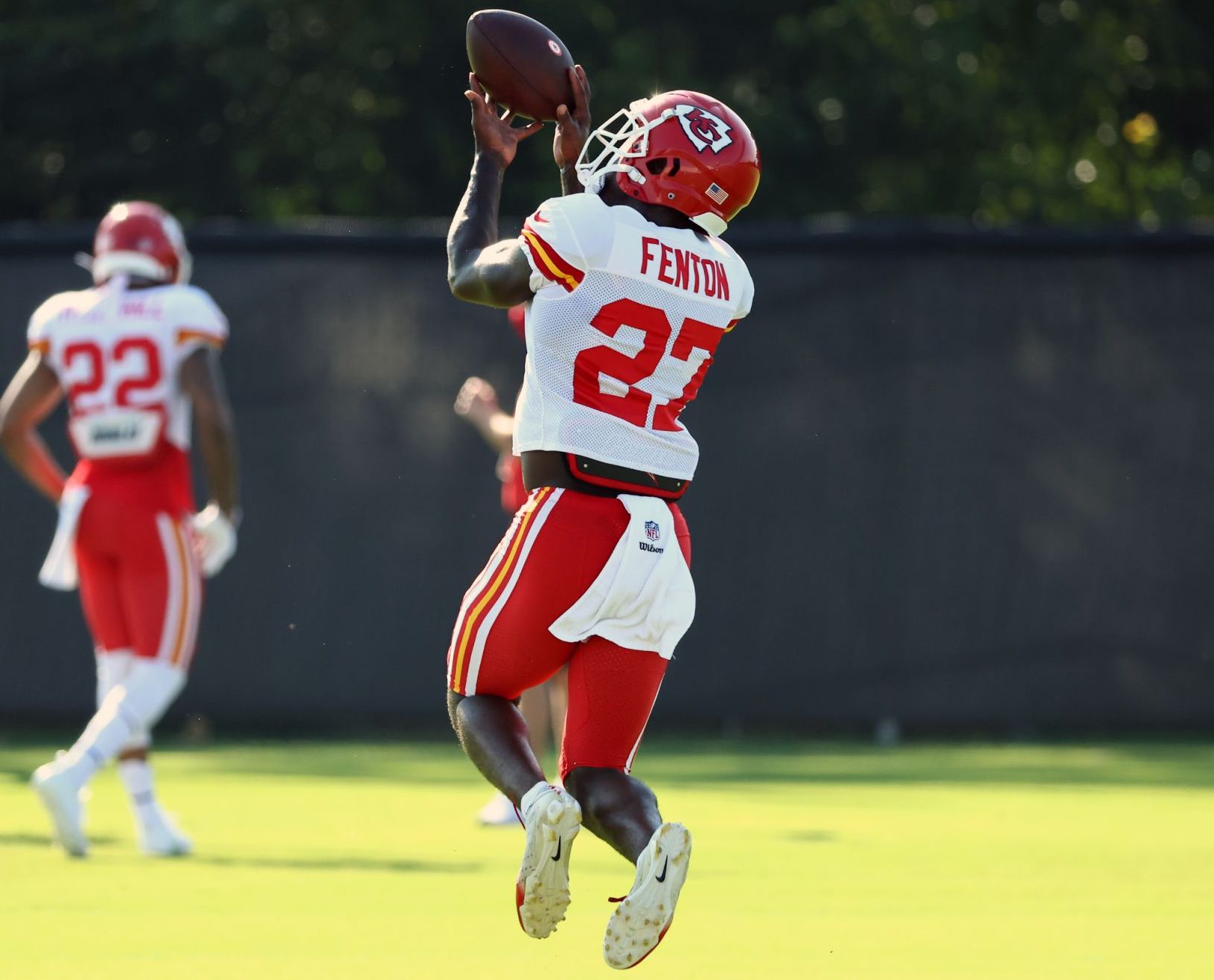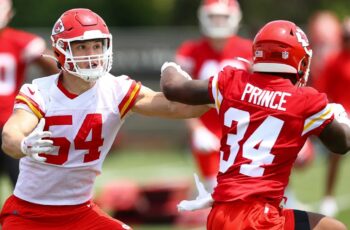KANSAS CITY, Mo. — The NFL’s new dynamic kickoff faced its first serious challenge in Saturday night’s Chiefs-Jaguars contest. While the officials eventually got the call right on the field the question remains if the rule needs some tweaks.
With 26 seconds left in the first half, Jacksonville’s Cam Little sent a kickoff toward returner Deneric Prince, who let the ball bounce into the end zone. Fellow returner Mecole Hardman, realizing a kickoff landing in the end zone is a live ball, attempted to corral the loose ball and down it in the end zone. The ball rolled out to the 1-yard line and Hardman took a knee before retrieving the ball and pulling it behind the goal line in his grasp. Officials on the field initially ruled the play a touchback but after a replay review overturned the call to a safety.
The NFL says safety was the correct call and stands behind the ruling, a league source confirmed Sunday to Chiefs Digest. Neither the league nor the officiating crew informed the club that the safety ruling was incorrect, a team source told Chiefs Digest.
That doesn’t mean the controversy and confusion will go away anytime soon. Even some officials and rules experts weren’t entirely clear the correct call was made. Here’s an explanation of the confusion and where the league may need to go next in clarifying the new dynamic kickoff rule.
Live Ball in the End Zone
The confusing kickoff and its outcome helped highlight a widely misunderstood aspect of the new rule: a kickoff landing in the end zone or bouncing off a player or the ground in the landing zone remains a live ball.
Prince appeared to misunderstand that rule — in fairness, head coach Andy Reid also appeared confused by the rule. “Normally when the ball goes in the end zone and you touch it there, then it’s a dead ball,” Reid said after the game. But that’s under the old kickoff rule, not the new standard.
The NFL’s primer on the kickoff rule specifies: “Kick hits in end zone, stays inbounds – returned or downed – if downed then touchback to B30 yard line.” An accompanying video — both of which have been provided by the NFL to clubs and players — states, “If the ball enters the end zone in the air, the receiving team return it or down it and take possession at its 30-yard line.”
While not stating implicitly that a kickoff landing in the end zone is a live ball, both sources indicate the receiving team can return or down the ball. Once the ball lands in the end zone, it’s a live ball unless it goes out of bounds. Any kickoff that goes out of bounds in the end zone in the air or after bouncing in the end zone results in a touchback at the 30-yard line. If a ball lands in the end zone and doesn’t go out of bounds, the receiving team must either return the kick or down the ball in the end zone.
What Did the Chiefs Do Wrong?
The entire scenario could have been avoided had Prince received the ball in the end zone and taken a knee. That would have resulted in a touchback at the 30-yard line.
When Hardman saw Prince let the ball go, his instincts were 100% correct. It was a live ball and must be returned or downed in the end zone. Had Hardman retrieved the ball in the end zone and taken a knee, the result would have been the same with Kansas City taking possession at its 30-yard line.
It was unfortunate for Hardman that the ball bounced out of the end zone. When the ball leaves the end zone, it can no longer be downed for a touchback unless the ball were to roll or bounce back across the goal line without being touched by the returning team.
Hardman applied what the NFL Rulebook calls “impetus.” Its definition in the Rulebook: “Impetus is the action of a player who carries the ball or provides the force (i.e., a pass, kick, snap, or fumble) that causes a ball in the field of play to touch or cross a goal line.”
When Hardman touched the ball to retrieve it from the 1-yard line and pull it into the end zone, he applied impetus to the ball. In essence, Hardman has now caused the movement of the football, and he’s responsible for where it goes next. His action caused the ball to go into the end zone.
Forward progress doesn’t apply here since Hardman wasn’t held or restrained by a defender. The ball isn’t dead when Hardman touches it. The ball is ruled dead only when the ball carrier has secured possession and declared himself down. When that happened, the ball was in Hardman’s possession in the end zone and he caused the ball to move behind the goal line. That makes the ruling of safety the correct call.
Is There Anything Wrong with the Rule?
The NFL adopted the dynamic kickoff rule for the 2024 season only with the expectation that adjustments may be required. One such tweak occurred last month when the league banned kickers from placing the ball sideways on the kicking tee. The Rulebook states the ball must be no more than 1 inch off the ground, and when the ball is placed sideways on a tee the ball is 1.5 inches off the ground.
“It’s a work in progress,” said NFL referee John Hussey during a July 27 session with Kansas City reporters. “That’s how it’s been explained to us.”
One thing that the rules makers may not have anticipated was what happened Saturday night. What happens when a kickoff bounces out of the end zone?
It’s possible rule makers did anticipate this possibility and expected players and teams to adjust to the new. The situation only developed because Prince did not attempt to receive the kick. Had he realized the ball was live, he would likely have received the kick and downed it for a touchback.
It’s also possible there wasn’t much consideration given to this situation. Reid suggested after the game more discussion may be necessary.
“I think they’re trying to work that out,” Reid said. “We’ll get it cleared up and see what they come up with there.”
It seems unlikely the NFL will change its stance on the kickoffs landing in the end zone being a live ball. The league wants returns, not returners letting the ball go into the end zone for a touchback.
The immediate solution is for teams and returners to remain cognizant that a ball landing in the end zone is a live ball. Whether it’s downed in the end zone or the ball goes out of bounds, the result is still a touchback to the 30-yard line. There is little upside for players to allow the ball to bounce in the end zone since it can also bounce back into the field of play. The league hopes kickoffs caught behind the goal line will be returned more frequently.



